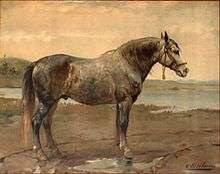Russian Heavy Draft
The Russian Draft or Russian Heavy Draft (Russian: Русский тяжеловоз, Russkii Tyazhelovoz) is a Russian breed of draft horse. It was bred in Imperial Russia in the second half of the nineteenth century, and until after the Russian Revolution was known as the Russian Ardennes. It is one of a number of draft breeds developed there at approximately the same time, others being the Lithuanian Heavy Draft, the Soviet Heavy Draft and the Vladimir Heavy Draft; it is both the oldest and the smallest of them.[4]:499 The present name dates from the Soviet era, and was used from 1952.[6]:277
 Painting by Otto Eerelman of a Russian draft horse; Paardenrassen Kunstalbum, 1898 | |
| Conservation status | FAO (2007): not at risk[1]:99 |
|---|---|
| Other names | |
| Country of origin | Russian Federation |
| Distribution | |
| Use | |
| Traits | |
| Weight | |
| Height | |
| Colour | |
History

Selective breeding of what would become the Russian Ardennes began in the 1860s at the Petrovsky Agricultural and Forestry Academy in Moscow and at various stud farms including the Khrenov Stud in Voronezh Oblast, and the Derkul Stud in Ukraine. From about this time, stallions of the Franco-Belgian Ardennais heavy horse were imported to the Russian Empire from Sweden in increasing numbers; between 1875 and 1915, their number grew from nine to almost six hundred.[6]:277[5]:323 These were put to local mares; some Brabançon, Percheron and Orlov Trotter blood was also introduced.[3]:268 The aim was to produce a compact draft animal suitable for farm work.[6]:277 The Russian Ardennes was presented at the Exposition Universelle in Paris in 1900.[5]:323
As with other Russian horse breeds, the events of the First World War and the Russian Revolution caused a severe decline in numbers; in 1924, fewer than a hundred stallions remained. By 1937 the breed was re-established;[5]:323 the name was changed in 1952 to "Russkii Tyazhelovoz" or "Russian Heavy Draft".[6]:277 In the 1980s a population of almost fifty thousand was recorded,[5]:272 distributed in many parts of the Soviet Union – in Byelorussia, the North Caucasus, Udmurtia and Ukraine, in Western Siberia, and in the oblasts of Archangel, Kirov, Perm, Sverdlovsk and Vologda.[5]:323
Characteristics
The Russian Heavy Draft is a small powerful horse of heavy cob conformation, with lively gaits. The legs are short in comparison to the length of the body, and have little or no feathering;[6]:277 cannon-bone circumference is approximately 22 cm.[5]:323 Perhaps as a result of the Orlov Trotter influence, the head is not heavy.[6]:277 The horses are usually either chestnut or strawberry roan,[6]:277 but may also be bay.[3]:268 Among common defects are sickle hocks and weakness of the back.[6]:277
The horses are fast-growing, fertile and long-lived. Stallions have a fertility rate in the range of 80–85 percent, and may continue to stand at stud after the age of twenty.[6]:277 Foals weigh about 250 kg when weaned,[4]:499 and reach approximately 75% of full adult weight and 97% of full adult height in their first eighteen months of life.[6]:277
Use
The Russian Heavy Draft was originally bred for draft work in agriculture. In modern times, it is kept for its high milk yield. Mares may give approximately 2500 kg of milk in a normal lactation lasting six or seven months; the highest yield recorded for one lactation is 5540 kg.[4]:499 The milk is much used in the production of kumis.[3]:268 The Russian Heavy Draft is also raised for slaughter to supply meat.[3]:268 It has been used in cross-breeding in attempts to improve other breeds such as the Bashkir.[5]:333
References
| Wikimedia Commons has media related to Russian Heavy Draft. |
- Barbara Rischkowsky, D. Pilling (eds.) (2007). List of breeds documented in the Global Databank for Animal Genetic Resources, annex to The State of the World's Animal Genetic Resources for Food and Agriculture. Rome: Food and Agriculture Organization of the United Nations. ISBN 9789251057629. Accessed January 2017.
- Breed data sheet: Russkii Tyazhelovoz / Russian Federation (Horse). Domestic Animal Diversity Information System of the Food and Agriculture Organization of the United Nations. Accessed April 2019.
- Élise Rousseau, Yann Le Bris, Teresa Lavender Fagan (2017). Horses of the World. Princeton: Princeton University Press. ISBN 9780691167206.
- Valerie Porter, Lawrence Alderson, Stephen J.G. Hall, D. Phillip Sponenberg (2016). Mason's World Encyclopedia of Livestock Breeds and Breeding (sixth edition). Wallingford: CABI. ISBN 9781780647944.
- N.G. Dmitriev, L.K. Ernst (1989). Animal genetic resources of the USSR. FAO animal production and health paper 65. Rome: Food and Agriculture Organization of the United Nations. ISBN 9251025827. Archived 13 November 2009. Also available here, archived 29 September 2017.
- Elwyn Hartley Edwards (1994). The Encyclopedia of the Horse. London; New York; Stuttgart; Moscow: Dorling Kindersley. ISBN 0751301159.
Further reading
- И.И.Сорокина. Русская тяжеловозная порода. Всероссийский научно-исследовательский институт коневодства.
- = I.I. Sorokina. Russian Heavy Draft (in Russian). Moscow: All Russian Scientific Research Institute of Horse Breeding.